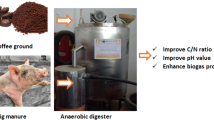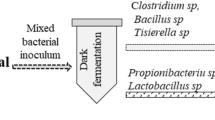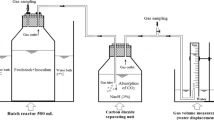Abstract
The aim of this study was the evaluation of the influence of temperature, initial organic load, and C/N ratio in the biochemical hydrogen potential (BHP) by dark fermentation (DF) of mixtures composed of residual biomass derived from the Colombian agro-industry (pig manure, cocoa mucilage, and coffee mucilage) to contribute to residue management and the development of a bio-based economy in Colombia. A Box-Behnken experimental design was constructed, where the variables were as follows: three initial organic loads (2, 5, and 8 g COD/l), three C/N ratios (25, 35, and 45), and three different coffee and cocoa initial COD ratios (coffee mucilage (CFM):cocoa mucilage (CCM)) (1:3, 2:2, and 3:1). The experiments were carried out at thermophilic environments of 55 °C and 45 °C. Sludge from an anaerobic digester pretreated by thermal shock was used as an inoculum. The results of the experimental designs were used (one per temperature) to model the system mathematically. Also, a mathematical model MARS (multivariate adaptive regression splines) was used as an alternative method to corroborate the optimal points obtained. In both models, it was evidenced that at 55 °C and 45 °C, the best mixing conditions indicated a C/N ratio of 45 and the lowest CFM:CCM with a value close to 1:3. Likewise, it was evidenced that at the temperature of 55 °C, the optimum organic load is 8 g COD/l, while 45 °C is 2 g COD/l. Moreover, it was determined that CFM:CCM has less influence than the other independent variables studied, a factor that favors the country’s scope, due to the availability of these two substrates is not permanent throughout the year.






Similar content being viewed by others
References
Valdez-Vazquez I, Poggi-Varaldo HM (2009) Hydrogen production by fermentative consortia. Renew Sust Energ Rev 13:1000–1013. https://doi.org/10.1016/j.rser.2008.03.003
Zuberi MJS, Ali SF (2015) Greenhouse effect reduction by recovering energy from waste landfills in Pakistan. Renew Sust Energ Rev 44:117–131. https://doi.org/10.1016/j.rser.2014.12.028
Davis CB, Aid G, Zhu B (2017) Secondary resources in the bio-based economy: a computer assisted survey of value pathways in academic literature. Waste Biomass Valoriz 8:2229–2246. https://doi.org/10.1007/s12649-017-9975-0
Bioraffinage – biobased economy, https://www.biobasedeconomy.nl/wat-is-biobased-economy/themas/bioraffinage_v2/. Accessed 10 May 2019
Bolétin Técnico- Residuos Sólidos, https://www.dane.gov.co/files/investigaciones/pib/ambientales/cuentas_ambientales/cuentas-residuos/Bt-Cuenta-residuos-2016p.pdf. Accessed 10 May 2019
Perspectivas agropecuarias, https://www.finagro.com.co/sites/default/files/2014_09_09_perspectivas_agropecuarias.pdf. Accessed 10 May 2019
Roldán JB, Herrera CJ, Abad AV, Delgado EEF, García NA, Lozano BG, Acevedo AVV, Contreras MAC, Hernández CG (2005) Matrız de empleo en la base 2005 de las cuentas nacıonales. https://www.dane.gov.co/files/investigaciones/pib/especiales/Documento_matriz_empleo.pdf. Accessed 10 May 2019
Algrano - El sector cafetero es motor de la economía y garantía de estabilidad y paz social, https://www.federaciondecafeteros.org/algrano-fnc-es/index.php/comments/el_sector_cafetero_es_motor_de_la_economia_y_garantia_de_estabilidad_y_paz_/. Accessed 14 May 2019
Hernández MA, Rodríguez Susa M, Andres Y (2014) Use of coffee mucilage as a new substrate for hydrogen production in anaerobic co-digestion with swine manure. Bioresour Technol 168:112–118. https://doi.org/10.1016/j.biortech.2014.02.101
Dinero: Producción de café colombiano repuntó en mayo de 2018, http://www.dinero.com/empresas/articulo/subio-produccion-de-cafe-colombiano-en-mayo-de-2018/259051. Accessed 11 Dec 2019
Montilla-Pérez, J., Arcila-Pulgarín, J., Aristizábal-Loaiza, M., Montoya, E.C., Puerta-Quintero, G.I., Oliveros-Tascón, C.E.: Propıedades físıcas y factores de conversıón del café en el proceso de benefıcıo. http://biblioteca.cenicafe.org/bitstream/10778/358/1/avt0370.pdf. Accessed 16 Dec 2019
Federación Nacional de Cafeteros - Sitio de la Federación Nacional de Cafeteros, https://federaciondecafeteros.org/. Accessed 12 Dec 2019
Inteligencia de Mercado: Cacao, https://www.finagro.com.co/sites/default/files/node/basic-page/files/ficha_cacao_version_ii.pdf. Accessed 16 Dec 2019
Fedecacao - Federación Nacional de Cacaoteros, https://www.fedecacao.com.co/portal/index.php/es/. Accessed 16 Dec 2019
Ortiz K, Álvarez R (2015) Efecto del vertımıento de subproductos del benefıcıo de cacao (Theobroma cacao l.) sobre algunas propıedades químıcas y bıológıcas en los suelos de una fınca acaotera, munıcıpıo de Yaguará (Huıla, Colombıa). Bol Científico Cent Mus Mus Hist Nat 19:65–84. https://doi.org/10.17151/bccm.2015.19.1.5
Argun H, Onaran G (2018) Dark fermentative hydrogen gas production from lime treated waste paper towel hydrolysate. Waste Biomass Valoriz 9:801–810. https://doi.org/10.1007/s12649-017-9957-2
Posso F, Narváez C, Ricardo A, Siguencia J, Sánchez J (2017) Use of municipal solid waste (MSW)-derived hydrogen in Ecuador: potential applications for urban transportation. Waste Biomass Valoriz. https://doi.org/10.1007/s12649-017-0161-1
Hernandez M, Gonzalez AJ, Suarez F, Ochoa C, Candela AM, Cabeza I (2018) Assessment of the biohydrogen production potential of different organic residues in Colombia: cocoa waste, pig manure and coffee mucilage. Chem Eng Trans 65:247–252. https://doi.org/10.3303/CET1865042
Análisis de coyuntura del sector porcicultor del año 2018 y perspectivas 2019, https://www.miporkcolombia.co/wp-content/uploads/2019/03/Bol_Inf_2018.pdf. Accessed 16 Dec 2019
Landín DGM TRATAMIENTO EXCRETAS CERDOS. http://www.produccion-animal.com.ar/produccion_porcina/00-produccion_porcina_general/63-excretas_cerdos.pdf. Accessed 26 Dec 2019
Balance y perspectivas del sector agropecuario 2013–2014, https://sac.org.co/balance-y-perspectivas-del-sector-agropecuario-2013-2014/, (2014). Accessed 16 Dec 2019
Ambientales, U.I. de S.C. de E. e I., Energética, U. de P.Mi., Instituto de Hidrología, M. y E.A.I. (2011)Atlas del potencial energético de la biomasa residual en Colombia.
Cárdenas ELM, Zapata-Zapata AD, Kim D (2019) Hydrogen production from coffee mucilage in dark fermentation with organic wastes. Energies. 12:71. https://doi.org/10.3390/en12010071
Kotsopoulos TA, Fotidis IA, Tsolakis N, Martzopoulos GG (2009) Biohydrogen production from pig slurry in a CSTR reactor system with mixed cultures under hyper-thermophilic temperature (70 °C). Biomass Bioenergy 33:1168–1174. https://doi.org/10.1016/j.biombioe.2009.05.001
Hernández M, Rodríguez M (2013) Hydrogen production by anaerobic digestion of pig manure: effect of operating conditions. Renew Energy 53:187–192. https://doi.org/10.1016/j.renene.2012.11.024
Xu S, Zhu J, Meng Z, Li W, Ren S, Wang T (2019) Hydrogen and methane production by co-digesting liquid swine manure and brewery wastewater in a two-phase system. Bioresour Technol 293:122041. https://doi.org/10.1016/j.biortech.2019.122041
Baghchehsaraee B, Nakhla G, Karamanev D, Margaritis A, Reid G (2008) The effect of heat pretreatment temperature on fermentative hydrogen production using mixed cultures. Int J Hydrog Energy 33:4064–4073. https://doi.org/10.1016/j.ijhydene.2008.05.069
Tang G-L, Huang J, Sun Z-J, Tang Q-Q, Yan C-H, Liu G-Q (2008) Biohydrogen production from cattle wastewater by enriched anaerobic mixed consortia: influence of fermentation temperature and pH. J Biosci Bioeng 106:80–87. https://doi.org/10.1263/jbb.106.80
Nakhjiri AT, Heydarinasab A, Bakhtiari O, Mohammadi T (2018) The effect of membrane pores wettability on CO2 removal from CO2/CH4 gaseous mixture using NaOH, MEA and TEA liquid absorbents in hollow fiber membrane contactor. Chin J Chem Eng 26:1845–1861. https://doi.org/10.1016/j.cjche.2017.12.012
Ahnazarova, S Akhnazarova, S., Kafarov, V: Experiment optimization in chemistry and chemical engineering. (1982)
Friedman JH (1991) Multivariate adaptive regression splines. Ann Stat 19:1–67. https://doi.org/10.1214/aos/1176347963
Nisbet R, Elder J, Miner G (2009) Chapter 8 - advanced algorithms for data mining. In: Nisbet R, Elder J, y Miner G (eds) Handbook of statistical analysis and data mining applications. Academic Press, Boston, pp 151–172
Albalasmeh AA, Berhe AA, Ghezzehei TA (2013) A new method for rapid determination of carbohydrate and total carbon concentrations using UV spectrophotometry. Carbohydr Polym 97:253–261. https://doi.org/10.1016/j.carbpol.2013.04.072
Phyllis2 - database for biomass and waste, https://phyllis.nl/
Vriesmann LC, Teófilo RF, de Petkowicz CLO (2011) Optimization of nitric acid-mediated extraction of pectin from cacao pod husks (Theobroma cacao L.) using response surface methodology. Carbohydr Polym 84:1230–1236. https://doi.org/10.1016/j.carbpol.2011.01.009
Argun H, Dao S (2015) Hydrogen gas production from waste peach pulp by dark fermentation and electrohydrolysis. Int J Hydrog Energy. https://doi.org/10.1016/j.ijhydene.2015.11.170
Buitrón G, Carvajal C (2010) Biohydrogen production from tequila vinasses in an anaerobic sequencing batch reactor: effect of initial substrate concentration, temperature and hydraulic retention time. Bioresour Technol 101:9071–9077. https://doi.org/10.1016/j.biortech.2010.06.127
Wang Y-Z, Zhang L, Xu T, Ding K (2017) Influence of initial anolyte pH and temperature on hydrogen production through simultaneous saccharification and fermentation of lignocellulose in microbial electrolysis cell. Int J Hydrog Energy 42:22663–22670. https://doi.org/10.1016/j.ijhydene.2017.07.214
Qi N, Hu X, Zhao X, Li L, Yang J, Zhao Y, Li X (2018) Fermentative hydrogen production with peanut shell as supplementary substrate: effects of initial substrate, pH and inoculation proportion. Renew Energy 127:559–564. https://doi.org/10.1016/j.renene.2018.05.018
Lu C, Zhang Z, Zhou X, Hu J, Ge X, Xia C, Zhao J, Wang Y, Jing Y, Li Y, Zhang Q (2018) Effect of substrate concentration on hydrogen production by photo-fermentation in the pilot-scale baffled bioreactor. Bioresour Technol 247:1173–1176. https://doi.org/10.1016/j.biortech.2017.07.122
Carosia MF, dos Reis CM, Sakamoto IK, Varesche MBA, Silva EL (2017) Influence of C/P and C/N ratios and microbial characterization in hydrogen and ethanol production in an anaerobic fluidized bed reactor. Int J Hydrog Energy 42:9600–9610. https://doi.org/10.1016/j.ijhydene.2017.01.127
Khanal SK, Chen W-H, Li L, Sung S (2004) Biological hydrogen production: effects of pH and intermediate products. Int J Hydrog Energy 29:1123–1131. https://doi.org/10.1016/j.ijhydene.2003.11.002
Lin C-Y, Hung C-H, Chen C-H, Chung W-T, Cheng L-H (2006) Effects of initial cultivation pH on fermentative hydrogen production from xylose using natural mixed cultures. Process Biochem 41:1383–1390. https://doi.org/10.1016/j.procbio.2006.01.021
Tsigkou K, Tsafrakidou P, Athanasopoulou S, Zafiri C, Kornaros M (2019) Effect of pH on the anaerobic fermentation of fruit/vegetables and disposable nappies hydrolysate for bio-hydrogen production. Waste Biomass Valoriz. https://doi.org/10.1007/s12649-019-00854-z
Vasmara C, Marchetti R (2017) Initial pH influences in-batch hydrogen production from scotta permeate. Int J Hydrog Energy 42:14400–14408. https://doi.org/10.1016/j.ijhydene.2017.04.067
Agler MT, Wrenn BA, Zinder SH, Angenent LT (2011) Waste to bioproduct conversion with undefined mixed cultures: the carboxylate platform. Trends Biotechnol 29:70–78. https://doi.org/10.1016/j.tibtech.2010.11.006
Liu N, Jiang J, Yan F, Xu Y, Yang M, Gao Y, Aihemaiti A, Zou Q (2018) Optimization of simultaneous production of volatile fatty acids and bio-hydrogen from food waste using response surface methodology. RSC Adv 8:10457–10464. https://doi.org/10.1039/C7RA13268A
Wainaina S, Lukitawesa N, Kumar Awasthi M, Taherzadeh MJ (2019) Bioengineering of anaerobic digestion for volatile fatty acids, hydrogen or methane production: a critical review. Bioengineered. 10:437–458. https://doi.org/10.1080/21655979.2019.1673937
Mu Y, Yu H-Q, Wang Y (2006) The role of pH in the fermentative H2 production from an acidogenic granule-based reactor. Chemosphere. 64:350–358. https://doi.org/10.1016/j.chemosphere.2005.12.048
Shida GM, Sader LT, Cavalcante de Amorim EL, Sakamoto IK, Maintinguer SI, Saavedra NK, Amâncio Varesche MB, Silva EL (2012) Performance and composition of bacterial communities in anaerobic fluidized bed reactors for hydrogen production: effects of organic loading rate and alkalinity. Int J Hydrog Energy 37:16925–16934. https://doi.org/10.1016/j.ijhydene.2012.08.140
Sreethawong T, Niyamapa T, Neramitsuk H, Rangsunvigit P, Leethochawalit M, Chavadej S (2010) Hydrogen production from glucose-containing wastewater using an anaerobic sequencing batch reactor: effects of COD loading rate, nitrogen content, and organic acid composition. Chem Eng J 160:322–332. https://doi.org/10.1016/j.cej.2010.03.037
Ghimire A, Trably E, Frunzo L, Pirozzi F, Lens PNL, Esposito G, Cazier EA, Escudié R (2018) Effect of total solids content on biohydrogen production and lactic acid accumulation during dark fermentation of organic waste biomass. Bioresour Technol 248:180–186. https://doi.org/10.1016/j.biortech.2017.07.062
Hallenbeck PC (ed) (2012) Microbial technologies in advanced biofuels production. Springer, New York
Funding
The authors received financial support from Colciencias (Administrative Department of Science, Technology, and Innovation)—Project number FP44842-38-2017—contract 038-2017 and the Call 771 of the Santander 2017.
Author information
Authors and Affiliations
Corresponding author
Additional information
Publisher’s Note
Springer Nature remains neutral with regard to jurisdictional claims in published maps and institutional affiliations.
Rights and permissions
About this article
Cite this article
Rangel, C.J., Hernández, M.A., Mosquera, J.D. et al. Hydrogen production by dark fermentation process from pig manure, cocoa mucilage, and coffee mucilage. Biomass Conv. Bioref. 11, 241–250 (2021). https://doi.org/10.1007/s13399-020-00618-z
Received:
Revised:
Accepted:
Published:
Issue Date:
DOI: https://doi.org/10.1007/s13399-020-00618-z




